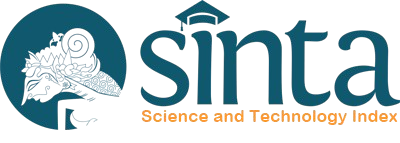Author Guidelines
Submission Preparation Checklist
As part of the submission process, authors are required to check off their submission's compliance with all of the following items, and submissions may be returned to authors that do not adhere to these guidelines.
- The submission has not been previously published, nor is it before another journal for consideration (or an explanation has been provided in Comments to the Editor).
- The submission file is in OpenOffice, Microsoft Word, or RTF document file format.
- Where available, URLs for the references have been provided.
- The text is double-spaced; uses a 12-point font of Times New Roman; employs italics, rather than underlining (except with URL addresses); and all illustrations, figures, and tables are placed at the end of the text.
- The manuscript used a one-column format and show continuous line numbers.
- The text adheres to the stylistic and bibliographic requirements outlined in the Author Guidelines.
The submission includes 1) Main text, and 2) Title page. The title page is uploaded separately as a supplementary file. Do NOT combine the main text with the title page. There are no author names and affiliations in the main text. All files are in doc. or docx format. Do NOT submit files in RTF or pdf format. A copyright form is not required.
TITLE PAGE FILE:
This must include the following information:
- Title of the manuscript
- Names (spelled out in full) of all the authors*, and the institutions with which they are affiliated)
- Corresponding author's details (name, email, mailing address, telephone and fax numbers)
- Declaration of conflict of interest
- Funding
- Acknowledgment
MAIN TEXT FILE:
As the general, the Margin 1 inch or 2.54 cm (top, left, right, and bottom), A4 paper size, double space, and all references should be used by reference managers such as Mendeley or EndNote.
Please refer to the type of manuscript you are planning to submit, and follow the guidance provided. Or, you can choose a reporting guideline from EQUATOR Network or NLM’s Research Reporting Guidelines and Initiatives.
- Original Article (Quantitative Studies; Qualitative studies; Mixed Methods)
- Review Article
- Editorial
- Perspectives
- Case Study
- Letter to Editor
ORIGINAL ARTICLE
Quantitative Studies
TITLE: Title should be written concisely and Capital Each Words, bold, double space, Arial font style, and 12pt font size
ABSTRACT: Structure abstract is used in quantitative study design. It consists of five headings: Background, Purpose, Methods, Results, and Conclusions. The abstract should be no more than 250 words. Wording should be concise, present only the essential elements, and abbreviations are not allowed in the abstract.
Keywords: Immediately after the abstract, provide a minimum of 3 keywords and a maximum of 5 keywords and avoid general and plural terms and multiple concepts. The Keywords should be referring to https://meshb.nlm.nih.gov/search
Main Text: Quantitative studies should follow the headings: Introduction, Materials and Methods (design, sample and setting, variable, instruments, intervention (for experimental study), data collection, data analysis, and ethical consideration), Results, Discussion, Conclusions, Declaration of Interest, Acknowledgment, Funding, Data Availability, and References. Tables and figures can be inserted within the text or at the end of references. Articles submitted should not exceed 7000 words (minimum 5000 words) for the main text, including abstract, tables, and references.
Qualitative Studies
TITLE: Title should be written concisely and Capital Each Words, bold, double space, Arial font style, and 12pt font size
ABSTRACT: Structure abstract is used in qualitative study design. It consists of five headings: Background, Purpose, Methods, Results, and Conclusions. The abstract should be no more than 250 words. Wording should be concise, present only the essential elements, and abbreviations are not allowed in the abstract.
Keywords: Immediately after the abstract, provide a minimum of 3 keywords and a maximum of 5 keywords and avoid general and plural terms and multiple concepts. The Keywords should be referring to https://meshb.nlm.nih.gov/search
Main Text: Qualitative studies should follow the headings: Introduction, Materials and Methods (design, participants and Setting, ethical consideration, data collection, data analysis, and trustworthiness), Results, Discussion, Conclusions, Declaration of Interest, Acknowledgment, Funding, Data Availability, and References. Tables and figures can be inserted within the text or at the end of references. Articles submitted should not exceed 7000 words (minimum 5000 words) for the main text, including abstract, tables, and references.
Mixed-Methods Studies
TITLE: Title should be written concisely and Capital Each Words, bold, double space, Arial font style, and 12pt font size
ABSTRACT: Structure abstract is used in mixed-methods study design. It consists of five headings: Background, Purpose, Methods, Results, and Conclusions. The abstract should be no more than 250 words. Wording should be concise, present only the essential elements, and abbreviations are not allowed in the abstract.
Keywords: Immediately after the abstract, provide a minimum of 3 keywords and a maximum of 5 keywords and avoid general and plural terms and multiple concepts. The Keywords should be referring to https://meshb.nlm.nih.gov/search
Main Text: Mixed methods studies should follow the headings: Introduction, Materials and Methods (design, participants/sample, data collection, Validity and reliability/Trustworthiness, data analysis, and ethical consideration), Results, Discussion, Conclusions, Declaration of Interest, Acknowledgment, Funding, Data Availability, and References. Tables and figures can be inserted within the text or at the end of references. Articles submitted should not exceed 7000 words (minimum 5000 words) for the main text, including abstract, tables, and references.






